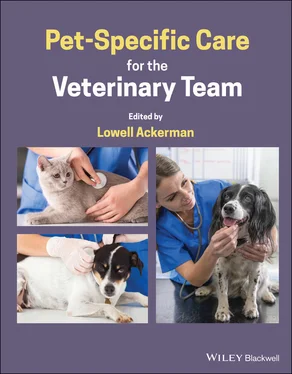Anything you want to teach clients about has to be taught to your team first and they need to know exactly what to say or do in order to get client acceptance of any wellness recommendations, including breed risk ones. Think about and discuss scripts for breed‐related testing if you want to educate clients in this area; for example, “Boxers are at risk for serious heart problems. The doctor will talk to you about ECG screening…”
The only way you can help your patients lead long and healthy lives is to educate their owners (see 5.10Discussing Pet‐Specific Care). Most of your clients don't have a degree in medicine or behavior. Take the time and make the effort to teach them what they need to know to care for their pets properly. It's not only good medicine – it's well worth the effort for your practice.
 EXAMPLES
EXAMPLES
Here are samples of healthcare programs for two different breeds. For each item marked as needing client education, you would need to have or develop a handout or other tool to use with clients. Items in bold would become part of your screening or preventative program at the appropriate age.
Healthcare considerations for a Doberman pinscher
| System |
Recommendation |
| Behavior |
Males may be aggressive; prone to flank sucking, lick granulomas |
| Cardiac |
Dilated cardiomyopathy (DCM) very common – annual ECG screento look for ventricular premature contractions (VPCs), consider annual echocardiogram/Pro‐BNP, client education, recommend pet health insurance when young |
| Dermatological |
Seasonal flank alopecia; lick granulomas; pemphigus; zinc‐responsive dermatosis |
| Drug reactions |
Avoid sulfa drugs which can increase risk for keratoconjunctivitis sicca (KCS) and adverse drug reactions |
| Gastrointestinal |
Prone to foreign body, bloat. Client education. Consider gastropexy during neutering surgery. Recommend pet health insurance when young |
| Hemolymphatic |
von Willebrand disease very common in breed. Screen for clotting ability (DNA test, buccal bleeding time or von Willebrand factor)before surgery or dental extractions. Recommend pet health insurance |
| Chronic active hepatitis |
Periodic liver function testing |
| Hypothyroidism |
Periodic thyroid profiles, starting with baseline at 1 year of age |
| Neurological |
Intervertebral disc disease (cervical), Wobbler's, narcolepsy. Client education |
| Ophthalmic |
Cataracts, progressive retinal atrophy – appropriate screening |
| Orthopedic |
Hip dysplasia, anterior cruciate ligament tear. Client education, recommend pet health insurance |
| Infectious diseases |
Potentially increased susceptibility to parvovirus vaccination. Consider vaccination booster at 5 months of age; titers |
| Urology |
Glomerulonephropathy (GN) – consider annual urine protein:creatinine ratio |
Healthcare considerations for a Boston terrier
| Dentistry |
Periodontal disease – frequent dental cleanings, client education; failure of canine teeth to erupt – check dentition at 5–6 months of age |
| Dermatological |
Alopecia, atopic dermatitis (hyperadrenocorticism) – client education; demodicosis more common – skin scrape early if clinical presentation consistent |
| Reproductive |
Dystocia can be an issue – client education if breeding |
| Gastroenterological |
Pyloric stenosis more common |
| Neoplastic |
Mast cell tumor (MCT), melanoma – fine needle aspirate (FNA)/remove all lumps |
| Neurological |
Hydrocephalus – check for open fontanelles in puppies, monitor behavior |
| Ophthalmological |
Prolapse of nictitating membrane (cherry eye), corneal ulcers, pigmentary keratitis, corneal dystrophy – client education; cataracts – both juvenile and late onset; iris cysts; vitreal syneresis > glaucoma and cataracts; proptosis |
| Keratoconjunctivitis sicca |
Schirmer tear testroutinely |
| Respiratory |
Respiratory dysplasia, including hypoplastic trachea – client education, early surgery if needed, give estimate for soft palate surgery with spay/neuter estimate. Skilled individual to intubate at every age, to look for elongated soft palate |
3.13.6 DNA Testing Recommendation Scripts
3.13.6.1 Mixed‐Breed Composition
This is the test that identifies the likely breed components of a mixed‐breed dog. This is a one‐time investment that provides a lot of information about a dog's genetic make‐up, so we know what genetic diseases are likely or possible.
3.13.6.2 Acute Ventricular Dysrhythmia Syndrome
Also known as arrhythmogenic right‐ventricular cardiomyopathy (ARVC), this is a serious heart condition seen in boxers and boxer mixes. It can cause acute collapse and death. All boxers and boxer mix dogs should be DNA tested for this, ideally when they are young.
3.13.6.3 Hemophilia and von Willebrand Disease
There are quite a few different forms of inherited bleeding disorders, including von Willebrand disease. Failure of the blood to clot properly can range from mild to severe and can worsen with age. Von Willebrand disease is extremely common in several breeds, and they should be DNA tested for it. For other breeds, we usually do a less expensive buccal bleeding time instead of a DNA test whenever we are performing surgery, to make sure we don't have a problem with excessive bleeding.
Several breeds and their crosses may possess this variant that affects tolerance for ivermectin and many other drugs. If a dog inherits two copies of the MDR1 gene, one from each parent, we must be very careful with certain medications and usually choose not to use them at all. Dogs with one copy of the gene can usually tolerate low doses of drugs if they really need to be used. We recommend all dogs from susceptible breeds be tested so we can properly prescribe medications for them.
Exercise‐induced collapse (EIC) is just like it sounds – affected dogs collapse when exercising strenuously, especially in hot weather. This problem is seen especially in Labrador and golden retrievers but in other breeds as well. The problem is not common so we generally only test for it if a dog has symptoms or will be used for breeding.
 TAKE‐AWAYS
TAKE‐AWAYS
A great deal of the illness we see in dogs and cats is breed related.
Some heritable diseases can be tested for, enabling earlier diagnosis and intervention.
Some simply require awareness on the part of the owner as to what to watch for and when to call the veterinarian.
DNA screening is becoming an increasingly important component of pet healthcare.
Our goal is to try to make sure that every owner of an at‐risk breed knows about the diseases and problems that could affect their dog or cat and the testing or treatment that is currently available for them.
 MISCELLANEOUS
MISCELLANEOUS
Читать дальше

 EXAMPLES
EXAMPLES TAKE‐AWAYS
TAKE‐AWAYS MISCELLANEOUS
MISCELLANEOUS










